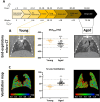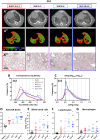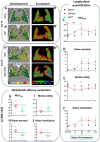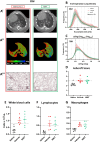Quantitative micro-CT-derived biomarkers elucidate age-related lung fibrosis in elder mice
- PMID: 39478545
- PMCID: PMC11526612
- DOI: 10.1186/s12931-024-03006-7
Quantitative micro-CT-derived biomarkers elucidate age-related lung fibrosis in elder mice
Abstract
Background: Idiopathic Pulmonary Fibrosis (IPF), prevalently affecting individuals over 60 years of age, has been mainly studied in young mouse models. The limited efficacy of current treatments underscores the need for animal models that better mimic an aged patient population. We addressed this by inducing pulmonary fibrosis in aged mice, using longitudinal micro-CT imaging as primary readout, with special attention to animal welfare.
Methods: A double bleomycin dose was administered to 18-24 months-old male C57Bl/6j mice to induce pulmonary fibrosis. Bleomycin dosage was reduced to as low as 75% compared to that commonly administered to young (8-12 weeks-old) mice, resulting in long-term lung fibrosis without mortality, complying with animal welfare guidelines. After fibrosis induction, animals received Nintedanib once-daily for two weeks and longitudinally monitored by micro-CT, which provided structural and functional biomarkers, followed by post-mortem histological analysis as terminal endpoint.
Results: Compared to young mice, aged animals displayed increased volume, reduced tissue density and function, and marked inflammation. This increased vulnerability imposed a bleomycin dosage reduction to the lowest tested level (2.5 µg/mouse), inducing a milder, yet persistent, fibrosis, while preserving animal welfare. Nintedanib treatment reduced fibrotic lesions and improved pulmonary function.
Conclusions: Our data identify a downsized bleomycin treatment that allows to achieve the best trade-off between fibrosis induction and animal welfare, a requirement for antifibrotic drug testing in aged lungs. Nintedanib displayed significant efficacy in this lower-severity disease model, suggesting potential patient stratification strategies. Lung pathology was quantitatively assessed by micro-CT, pointing to the value of longitudinal endpoints in clinical trials.
Keywords: Age; Bleomycin model; IPF; Lung fibrosis; Micro-computed tomography; Nintedanib.
© 2024. The Author(s).
Conflict of interest statement
FFS, AG, EF and GV are employees of Chiesi Farmaceutici S.p.A., that supported the research work. The remaining authors declare that the research was conducted in the absence of any commercial or financial relationships that could be construed as a potential conflict of interest.
Figures






Similar articles
-
Micro-CT-assisted identification of the optimal time-window for antifibrotic treatment in a bleomycin mouse model of long-lasting pulmonary fibrosis.Sci Rep. 2024 Jun 26;14(1):14792. doi: 10.1038/s41598-024-65030-3. Sci Rep. 2024. PMID: 38926490 Free PMC article.
-
Longitudinal microcomputed tomography detects onset and progression of pulmonary fibrosis in conditional Nedd4-2 deficient mice.Am J Physiol Lung Cell Mol Physiol. 2024 Dec 1;327(6):L917-L929. doi: 10.1152/ajplung.00280.2023. Epub 2024 Oct 22. Am J Physiol Lung Cell Mol Physiol. 2024. PMID: 39437758 Free PMC article.
-
Imaging Pulmonary Fibrosis and Treatment Efficacy In Vivo with Autotaxin-Specific PET Ligand [18F]ATX-1905.Mol Pharm. 2024 Oct 7;21(10):5171-5181. doi: 10.1021/acs.molpharmaceut.4c00571. Epub 2024 Aug 26. Mol Pharm. 2024. PMID: 39186477
-
A mouse model of progressive lung fibrosis with cutaneous involvement induced by a combination of oropharyngeal and osmotic minipump bleomycin delivery.Am J Physiol Lung Cell Mol Physiol. 2024 Jun 1;326(6):L736-L753. doi: 10.1152/ajplung.00408.2023. Epub 2024 Apr 23. Am J Physiol Lung Cell Mol Physiol. 2024. PMID: 38651940 Free PMC article.
-
Allies or enemies? The effect of regulatory T cells and related T lymphocytes on the profibrotic environment in bleomycin-injured lung mouse models.Clin Exp Med. 2023 Aug;23(4):1075-1088. doi: 10.1007/s10238-022-00945-7. Epub 2022 Nov 20. Clin Exp Med. 2023. PMID: 36403186 Free PMC article. Review.
Cited by
-
Spatial transcriptomic and morpho-functional information derived from single mouse FFPE slides allows in-depth fingerprinting of lung fibrosis.Respir Res. 2025 Jul 2;26(1):225. doi: 10.1186/s12931-025-03300-y. Respir Res. 2025. PMID: 40604969 Free PMC article.
References
-
- Raghu G, Remy-Jardin M, Myers JL, Richeldi L, Ryerson CJ, Lederer DJ, et al. Diagnosis of idiopathic pulmonary fibrosis. An Official ATS/ERS/JRS/ALAT Clinical Practice Guideline. Am J Respir Crit Care Med. 2018;198:e44–68. - PubMed
-
- Podolanczuk AJ, Thomson CC, Remy-Jardin M, Richeldi L, Martinez FJ, Kolb M, et al. Idiopathic pulmonary fibrosis: state of the art for 2023. Eur Respir J. 2023;61:2200957. - PubMed
-
- Trachalaki A, Irfan M, Wells AU. Pharmacological management of idiopathic pulmonary fibrosis: current and emerging options. Expert Opin Pharmacother. 2021;22:191–204. - PubMed
MeSH terms
Substances
LinkOut - more resources
Full Text Sources
Medical

